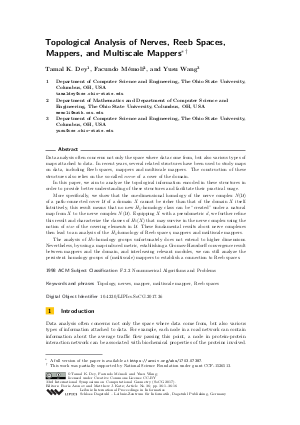Topological Analysis of Nerves, Reeb Spaces, Mappers, and Multiscale Mappers
Authors Tamal K. Dey, Facundo Mémoli, Yusu Wang
-
Part of:
Volume:
33rd International Symposium on Computational Geometry (SoCG 2017)
Part of: Series: Leibniz International Proceedings in Informatics (LIPIcs)
Part of: Conference: Symposium on Computational Geometry (SoCG) - License:
 Creative Commons Attribution 3.0 Unported license
Creative Commons Attribution 3.0 Unported license
- Publication Date: 2017-06-20
File

PDF
LIPIcs.SoCG.2017.36.pdf
- Filesize: 1.28 MB
- 16 pages
Document Identifiers
Subject Classification
Keywords
- Topology
- Nerves
- Mapper
- Multiscale Mapper
- Reeb Spaces
Metrics
- Access Statistics
-
Total Accesses (updated on a weekly basis)
0PDF Downloads0Metadata Views
Abstract
Data analysis often concerns not only the space where data come from, but also various types of maps attached to data. In recent years, several related structures have been used to study maps on data, including Reeb spaces, mappers and multiscale mappers. The construction of these structures also relies on the so-called nerve of a cover of the domain. In this paper, we aim to analyze the topological information encoded in these structures in order to provide better understanding of these structures and facilitate their practical usage. More specifically, we show that the one-dimensional homology of the nerve complex N(U) of a path-connected cover U of a domain X cannot be richer than that of the domain X itself. Intuitively, this result means that no new H_1-homology class can be "created" under a natural map from X to the nerve complex N(U). Equipping X with a pseudometric d, we further refine this result and characterize the classes of H_1(X) that may survive in the nerve complex using the notion of size of the covering elements in U. These fundamental results about nerve complexes then lead to an analysis of the H_1-homology of Reeb spaces, mappers and multiscale mappers. The analysis of H_1-homology groups unfortunately does not extend to higher dimensions. Nevertheless, by using a map-induced metric, establishing a Gromov-Hausdorff convergence result between mappers and the domain, and interleaving relevant modules, we can still analyze the persistent homology groups of (multiscale) mappers to establish a connection to Reeb spaces.
Cite As Get BibTex
Tamal K. Dey, Facundo Mémoli, and Yusu Wang. Topological Analysis of Nerves, Reeb Spaces, Mappers, and Multiscale Mappers. In 33rd International Symposium on Computational Geometry (SoCG 2017). Leibniz International Proceedings in Informatics (LIPIcs), Volume 77, pp. 36:1-36:16, Schloss Dagstuhl – Leibniz-Zentrum für Informatik (2017)
https://doi.org/10.4230/LIPIcs.SoCG.2017.36
BibTex
@InProceedings{dey_et_al:LIPIcs.SoCG.2017.36,
author = {Dey, Tamal K. and M\'{e}moli, Facundo and Wang, Yusu},
title = {{Topological Analysis of Nerves, Reeb Spaces, Mappers, and Multiscale Mappers}},
booktitle = {33rd International Symposium on Computational Geometry (SoCG 2017)},
pages = {36:1--36:16},
series = {Leibniz International Proceedings in Informatics (LIPIcs)},
ISBN = {978-3-95977-038-5},
ISSN = {1868-8969},
year = {2017},
volume = {77},
editor = {Aronov, Boris and Katz, Matthew J.},
publisher = {Schloss Dagstuhl -- Leibniz-Zentrum f{\"u}r Informatik},
address = {Dagstuhl, Germany},
URL = {https://drops.dagstuhl.de/entities/document/10.4230/LIPIcs.SoCG.2017.36},
URN = {urn:nbn:de:0030-drops-72220},
doi = {10.4230/LIPIcs.SoCG.2017.36},
annote = {Keywords: Topology, Nerves, Mapper, Multiscale Mapper, Reeb Spaces}
}
